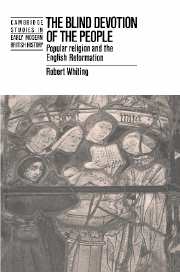Book contents
- Frontmatter
- Contents
- List of illustrations
- Preface
- Note
- 1 Introduction
- 2 Survey
- PART ONE ASSESSMENT
- 3 Dependent activities: sacraments, ceremonies and intercessions
- 4 Independent activities: prayers, images and cult objects
- 5 Inclusive institutions: parish churches, chapels and guilds
- 6 Exclusive institutions: papacy, religious orders and secular clergy
- 7 Summation of Part One
- PART TWO EXPLANATION
- Appendix 1 Maps
- Appendix 2 Graphs
- Bibliography and abbreviations
- Index
6 - Exclusive institutions: papacy, religious orders and secular clergy
Published online by Cambridge University Press: 11 December 2009
- Frontmatter
- Contents
- List of illustrations
- Preface
- Note
- 1 Introduction
- 2 Survey
- PART ONE ASSESSMENT
- 3 Dependent activities: sacraments, ceremonies and intercessions
- 4 Independent activities: prayers, images and cult objects
- 5 Inclusive institutions: parish churches, chapels and guilds
- 6 Exclusive institutions: papacy, religious orders and secular clergy
- 7 Summation of Part One
- PART TWO EXPLANATION
- Appendix 1 Maps
- Appendix 2 Graphs
- Bibliography and abbreviations
- Index
Summary
Of those Catholic institutions in which the layman played no part the most important to him on the eve of the Reformation were the papacy, the religious orders and the secular clergy.
Of these the most remote from him was inevitably the papacy. Nevertheless it would be mistaken to assume that this ancient institution was wholly absent from his religious consciousness. Popes, with their distinctive triple croziers and tiaras, were frequently depicted in his parish church. A window erected at St Neot in as late as 1528 shows the local saint receiving, as his supreme accolade, the blessing of the ‘holy father’. Thomas Becket, soon to be denounced by Henry VIII as an enemy of the royal supremacy in the English Church, was similarly honoured by murals, as at Breage, and by screen-paintings, as at Ashton. Parishes, moreover, still contributed their ‘Peter's Pence’ to the papal coffers. Thus at Morebath, according to the account for 1531, each householder paid ½d per annum, and each cotter ¼d. It was possibly as a receptacle for such payments that the hollow pre-Reformation lectern in Exeter Cathedral was originally employed. And to the anger of occasional critics – most notably of John Atwill of Walkhampton, who, in 1505–6, protested that they made money rather than saved souls – papal indulgences continued to be highly valued by many men and women.
- Type
- Chapter
- Information
- The Blind Devotion of the PeoplePopular Religion and the English Reformation, pp. 113 - 144Publisher: Cambridge University PressPrint publication year: 1989



